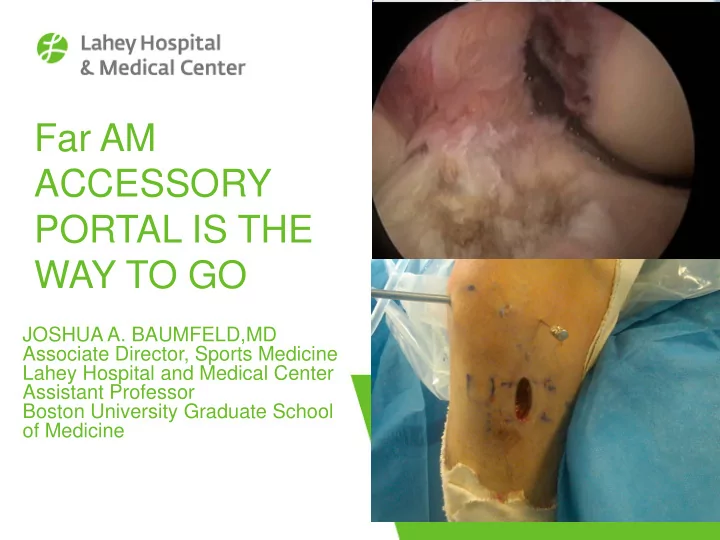

Far AM ACCESSORY PORTAL IS THE WAY TO GO JOSHUA A. BAUMFELD,MD Associate Director, Sports Medicine Lahey Hospital and Medical Center Assistant Professor Boston University Graduate School of Medicine
Disclosures • None 3
WHY CHANGE • AM portal is: • Yamamoto Y, Hsu WH, Woo SL, Van Scyoc AH, Takakura Y, Debski RE. Knee stability and graft function after anterior • More Anatomic cruciate ligament reconstruction: A comparison of a lateral and an anatomical femoral tunnel placement. Am J Sports Med • Better Biomechanics • Lee MC, Seong SC, Lee S, et al. Vertical femoral tunnel • Less Tunnel Widening placement results in rotational knee laxity after anterior cru- ciate ligament reconstruction. Arthroscopy 2007;23:771-778. • Better Kinematics • Pearle AD, Shannon FJ, Granchi C, Wickiewicz TL, Warren RF. Comparison of 3-dimensional obliquity and anisometric - In vivo and in vitro characteristics of anterior cruciate ligament graft positions using surgical navigation. Am J Sports Med 2008;36:1534- 1541. • Better Clinical Results • Scopp JM, Jasper LE, Belkoff SM, Moorman CT III. The effect of oblique femoral tunnel placement on rotational con- straint of the knee reconstructed using patellar tendon au- tografts. Arthroscopy 2004;20:294-299. 4
ANATOMY True ACL footprint: All on lateral femoral Condylar wall No fibers on the Roof! 5
Tangential to MFC Perpendicular to center of footprint Visualize through medial portal Avoid notchplasty 6
ANATOMY 7
ANATOMY Scanlan, et al, AJSM, 2009 TT AM portal TT- 61.2 +/- 24% of Fem tunnel within anatomic footprint AM Portal - 97.7% +/- 5% of Fem tunnel within anatomic footprint Thompkins, et al, AJSM, 2012
Proper Obliquity of the Graft Normal coronal 58%-75% Sagittal 45%-67% Transtibial • To get more anatomic on femur coronal 67-80 • More posterior on Tibia Sagittal 54-84 • Less oblique in Sagittal Plane AM portal • More Vertical Graft coronal 70.8 Sagittal 62.5 Marchant, et al, AJSM, 2010 9
“The negative correlation between peak external knee flexion moment during walking and the coronal angle of the anterior cruciate ligament graft indicates that as the anterior cruciate ligament graft is placed in a more vertical coronal orientation, patients reduce their net quadriceps usage during walking.” • Possibly linked to development of DJD 10
TUNNEL WIDENING • 38% larger tibial tunnel Bedi et al, Arthroscopy 2011 • 68 sqmm v 77 sqmm Thompkins, et al, AJSM, 2012 Zu et al, Arthroscopy, 2011 Chhabra, Harner, Arthroscpy,. 2006 11
Biomechanics 12
KINEMATICS • The AMP technique better restores the anterior-posterior translation during the swing phase and femoral external rotation at midstance than the TT technique does 13
CLINICAL RESULTS odds ratio [OR] = 2.49, 95% confidence interval [CI] = 1.30 to 4.78, p = 0.006) • 122 failures, 88% with TT technique. Many grafts still intact but patients were rotationally unstable 14
CLINICAL RESULTS • AMP technique is superior to the TT technique in providing anatomical placement of the graft and in recovery time to return sports Azboy et al, Arch Orthop Trauma Surg, 2014 Arthroscopy, 2013 • AM portal technique for ACLR may be more likely to produce improved clinical and biomechanical outcomes 15
TT AM KT. 2.7mm vs 1.7mm NL Lachman. 25/46 35/42 NL Pivot shift 23/46 36/42 DJD 28% 12% Same level of sports 30/46 35/42 16
Proposed Disadvantages to AM portal Use • Difficulty visualizing in hyperflexion • Remove excessive fat pad and synovium • Use a flexible system • Posterior wall blow out • Not an issue with far medial accessory portal as approach is more perpendicular • Technically demanding • Short learning curve—practice in the lab • Short tunnels • Tunnel lengths are over 30mm and adequate • 37.8mm vs 41.1mm (Chhabra, et al, AJSM, 2012) • Increased risk to Peroneal Nerve • 90 degrees or greater is safe in multiple. studies 17
Proposed Disadvantages to TT approach • Tibial tunnel dictates femoral tunnel • Leads to vertical and anterior graft placement • Vertical grafts = more rotational instability • Divergence of IF screws • Notchplasty required • NON ANATOMIC • The anatomic portion is mostly AM bundle • You get PL on tibia to AM on femur – at best. 18
“We resist changing because we are afraid of change.” Spencer Johnson Don’t be a dinosaur…. THANK YOU Or you’ll go extinct
Recommend
More recommend